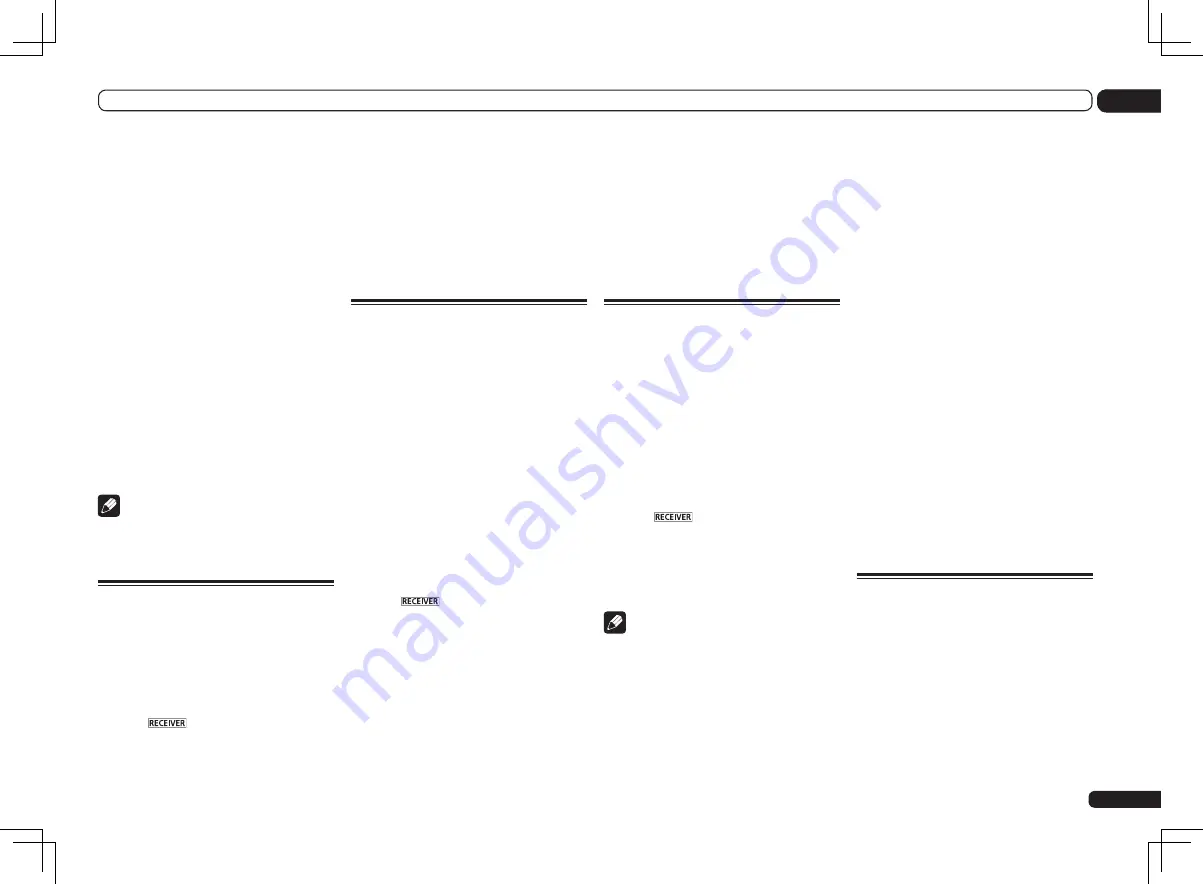
En
45
06
Listening to your system
2 While listening to a source,
press AUTO/ALC/DIRECT
(AUTO SURR/ALC/STREAM DIRECT) to
select the mode you want.
Check the digital format indicators in the front
panel display to see how the source is being
processed.
!
AUTO SURROUND
– See
Auto playback
on
page 43 .
!
ALC
– Listening in Auto level control mode
(page 43).
!
DIRECT
– Plays back sound from the
source with the least modification next
to
PURE DIRECT
. With
DIRECT
, the only
modifications added to
PURE DIRECT
playback are calibration of the sound field by
the MCACC system and the Phase Control
effect.
!
PURE DIRECT
– Plays back unmodified
sound from source with only minimal digital
treatment.
!
OPTIMUM SURR
– Listening in Optimum
Surround mode (page 43).
Note
!
When listening through headphones, you can
select
ALC
,
OPTIMUM SURR
or
PURE DIRECT
mode only.
Selecting MCACC presets
!
Default setting:
MEMORY 1
If you have calibrated your system for different
listening positions, you can switch between set-
tings to suit the kind of source you’re listening
to and where you’re sitting (for example, watch-
ing movies from a sofa, or playing a video game
close to the TV).
1 Press
to the receiver operation
mode.
2 While listening to a source, press
MCACC.
Press repeatedly to select one of the six MCACC
presets. See
Data Management
on page 75 to
check and manage your current settings.
!
These settings have no effect when
headphones are connected.
!
You can also press
k
/
l
to select the
MCACC preset.
Choosing the input signal
On this receiver, it is possible to switch
the input signals for the different inputs as
described below.
!
This receiver can only play back Dolby Digital,
PCM (32 kHz to 192 kHz) and DTS (including
DTS 96/24) digital signal formats. The
compatible signals via the HDMI terminals
are: Dolby Digital, DTS, PCM (32 kHz to 192
kHz), Dolby TrueHD, Dolby Digital Plus, DTS-
EXPRESS, DTS-HD Master Audio and SACD.
!
You may get digital noise when an LD, CD,
DVD or BD player compatible with DTS is
playing an analog signal. To prevent noise,
make the proper digital connections (page 22)
and set the signal input to
DIGITAL
.
!
Some DVD players don’t output DTS signals.
For more details, refer to the instruction
manual supplied with your DVD player.
1 Press
to the receiver operation
mode.
2 Press SIGNAL SEL to select the input
signal corresponding to the source
component.
Each press cycles through the options as
follows:
!
AUTO
– The receiver selects the first
available signal in the following order:
HDMI
;
DIGITAL
;
ANALOG
.
!
ANALOG
– Selects an analog signal.
!
DIGITAL
– Selects an optical or coaxial
digital signal.
!
HDMI
– Selects an HDMI signal.
—
When the
HDMI
audio output parameter
is set to
THROUGH
, the sound will be
heard through your TV, not from this
receiver.
When set to
DIGITAL
,
HDMI
or
AUTO
(only
selected
DIGITAL
or
HDMI
), the indicators light
according to the signal being decoded (see
Display
on page 10 ).
Better sound using Phase
Control
This receiver’s Phase Control feature uses
phase correction measures to make sure your
sound source arrives at the listening position in
phase, preventing unwanted distortion and/or
coloring of the sound.
Phase Control technology provides coherent
sound reproduction through the use of phase
matching for an optimal sound image. The
default setting is on and we recommend leav-
ing Phase Control switched on for all sound
sources.
1 Press
to the receiver operation
mode.
2 Press PHASE CTRL (PHASE CONTROL) to
switch on phase correction.
The
PHASE CONTROL
indicator on the front
panel lights.
Note
!
Phase matching is a very important factor
in achieving proper sound reproduction.
If two waveforms are ‘in phase’, they crest
and trough together, resulting in increased
amplitude, clarity and presence of the sound
signal. If a crest of a wave meets a trough,
then the sound will be ‘out of phase’ and an
unreliable sound image will be produced.
!
For discs created with standards other than
Phase Control, the LFE channel is delayed
upon recording in the first place. Phase
Control Plus function corrects for phase
shifting on such discs. For instructions on
setting the Phase Control Plus, see
Setting the
Audio options
on page 56 .
!
If your subwoofer has a phase control switch,
set it to the plus (+) sign (or 0º). However,
the effect you can actually feel when
PHASE CONTROL
is set to
ON
on this receiver
depends on the type of your subwoofer. Set
your subwoofer to maximize the effect. It is
also recommended you try changing the
orientation or the place of your subwoofer.
!
Set the built-in lowpass filter switch of your
subwoofer to off. If this cannot be done on
your subwoofer, set the cutoff frequency to a
higher value.
!
If the speaker distance is not properly set, you
may not have a maximized
PHASE CONTROL
effect.
!
The
PHASE CONTROL
mode cannot be set to
ON
in the following cases:
—
When headphones are plugged in.
—
When the
PURE DIRECT
mode is switched
on.
—
When the
HDMI
audio output parameter is
set to
THROUGH
in Setting the
Setting the
Audio options
on page 56 .
Better sound using Phase
Control and Full Band Phase
Control
This receiver is equipped with the two types
of functions that correct phase distortion and
group delay: Phase Control and Full Band
Phase Control. Activating Full Band Phase
Control is strongly recommended because it
also involves the effects of Phase Control.
The Full Band Phase Control feature calibrates
the frequency-phase characteristics of the
speakers connected.
Summary of Contents for Elite SC-55
Page 1: ...SC 57 SC 55 ...
Page 107: ...107 En 13 Additional information ...
















































